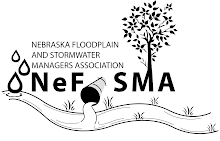Multipurpose Floodplain Mapping, Jude Kastens, Kansas Biological Survey
Attendees will gain a broad understanding of the concept of a physical floodplain (or river valley). This knowledge is useful for understanding flood mitigation efforts as well as floodplain ecological assessments (e.g., wetland characterization). Discussion will include different elevation datasets and standard hydrologic processing procedures, and introduce the KBS FLDPLN (“Floodplain”) model. FLDPLN is a conceptually simple, 2-dimensional hydrologic model capable of creating a continuum of floodplain maps associated with different stream stages. These maps have a wide variety of applications, including flood extent estimation and hydrologic connectivity assessment. Several examples will be shown.
Researchers at the Kansas Biological Survey (KBS) developed a topographic floodplain model (FLDPLN) that has been used to identify and map river valley floodplains for many rivers and stream networks, including the lower half of the Missouri River. FLDPLN uses simple hydrologic principles to estimate floodplain extent as a function of floodwater depth: backfill flooding to approximate backwater effects, and spillover flooding to approximate floodwater rerouting. Consequently, FLDPLN can be used for river valley identification, flood extent estimation, hydrologic connectivity indexing, and also for scenario modeling (e.g., a particular flood event, or connectivity impacts of adding or removing a levee). Model outputs have applications for river valley morphology assessment, ecological modeling, and flood disaster response mitigation and damage assessment, and can also facilitate traditional hydraulic studies.


No comments:
Post a Comment